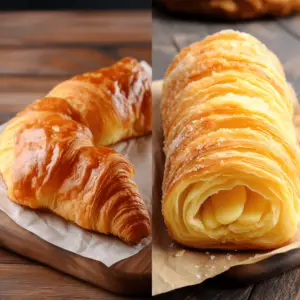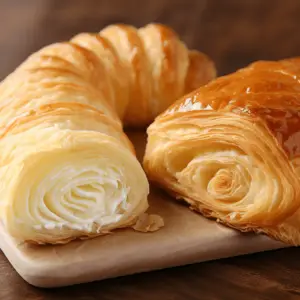Puff Pastry vs. Crescent Rolls, Great home-baked desserts part of a family meal or company meal are Puff pastry and Crescent Rolls. They are common on your tables during the holidays and are easy to prepare. Let’s dive into more details.
Table of Contents
Puff Pastry vs Crescent Rolls: Overview

Crescent Rolls
Crescent rolls are a product of bread-like yeast-raised dough seasoned with softened or melted butter. They have an appealing taste thanks to the addition of butter in large quantities.
Since immemorial, the crescent-shaped rolls have been pleasant to behold. Making them by hand can be tedious and needs skills, thus taking many days to complete. However, with revolution, factory-made, frozen, pre-formed, but unbaked dough has made it simpler for even the unskilled to make them nowadays.
You can add flavors like fresh herbs, nuts, coconut, or chocolate fillings as you would love into the dough, roll up the crescents, brush with egg, and bake.
The crescent rolls are a base for plump, homemade Danish rolls, and they are used in different recipes such as appetizers and casseroles to deserts.
The dough is smeared with melted or softened butter before it is cut into wedges and then rolled into crescent shapes. Some recipes suggest brushing the rolls with melted butter before baking in a regular egg wash.
Crescent roll-dough is light and a bit sweet, perfect for making knots, folding over, and other several shapes in addition to the regular crescent shape.
5 Crescent rolls sweet and savory recipes
Crescent rolls can be stuffed, basted, wrapped, and braided, making them a perfect base for many dishes. They are famous for making party food. They can be flavored, filled, or used as a crust in sweet and savory preparations such as:
Crescent Dogs
Cranberry-cream Cheese Crescent Bites
Apple Crescent Dumplings
Green Bean Casserole Crescent Cups
5-Ingredient Chicken Pot Pie Casserole
Puff Pastry
A light and flaky pastry made from dough that is produced by alternating layers of butter and dough laminated dough) refers to Puff Pastry.
It combines flour and other chilled ingredients rather than softened butter. Puff pastry contains neither yeast or baking powder. Its raising is strictly through the interactions of flour, water, salt, and several (small) butter layers rolled between them.
Puff pastry entails wrapping an ice block of butter in the dough, rolling it out, folding it over, and continuously redoing the process until you attain multiple layers of pastry dough. Take note that the dough requires to chill between each turn of rolling and folding, making the process cumbersome and time-consuming.
The butter layers aid in keeping the pastry layers separate as they bake, thus a crispy texture and a golden color. The water in the pastry evaporates as steam, causing the pastry layers to lift and separate (puff) as they cook.
A perfect-made puff pastry will quadruple in height as it bakes.
The traditional ways of making puff pastry are arduous; several hours are required, but once you master it, it is simple. The rolling and folding needs experience too. For this reason, many people opt for the ready dough version found in the freezers.
Regardless of the one you will use, the outcome is a light buttery pastry with a tiny crunch attached. It is used for beef wellington, turnovers, and pinwheels to palmiers.
Culinary uses
Making it from scratch is a no-joke task, but cooking with it is simpler than you can imagine! It is used to make pastries, sweet and savory dishes like appetizers to delicate desserts.
Keep the store-bought puff pastry frozen in a freezer for easy use during baking. For homemade puff pastry, refrigerate it for a few days, or if frozen in a freezer, it should be for a month. Ensure to rewrap the unused tightly in a plastic wrap.
Store any uncooked pastry in an airtight container inside the freezer for two weeks. When you are ready to cook them, remove them and take them to the oven straight away.
Five simple Savory Puff Pastry Recipes
Do you want to make something sweet or savory? Puff pastry is one of the best ingredients for cooking as it adds a crisp, buttery taste regardless of what you are making. Here is a list you can try:
- Gruyere, Mushroom, and Caramelized onion Bites
- Asparagus Tart
- Leek and onion Puff pastry tart
- Feta and spinach puff pastry appetizer
- Beet wellington
Puff pastry vs. Crescent Rolls

- They both bake to a high and crisp finish, with a golden brown color.
- The technique to make puff pastry and crescent rolls are similar
- Both are considered the lightest, flakiest, and most delicate pastries in a baker’s repertoire.
- Both are preserved by freezing in a freezer.
- Puff pastry and crescent rolls are homemade, but you can acquire the ready version from the stores.
- Puff pastry uses many butter layers and folds, giving it a flakier and crumbly texture than crescent rolls.
- Puff pastry has visible layers of delicately flaky dough
- Puff pastry, unlike crescent rolls, relies on combining flour and other chilled ingredients.
- The primary difference between the puff pastry and crescent rolls is their ingredients. The puff pastry has no leavening agents, while the crescent rolls contain yeast.
- Puff pastry needs a lot more time than the Crescent Rolls.
- Each has different uses in cuisine.
- The puffy pastry is laminated dough composed of dough and butter
- Crescent rolls are more of bread, and puff pastry is a pastry.
- While both are laminated dough, they differ, with puff pastry getting more folds than a crescent roll.
- Both have different uses when they act as a base for other dishes.
- None of the two is easy to make though puff pastry is more forgiving as it does contain yeast and takes half a day to a day, while crescent dough takes 2-3 days.
Puff pastry and crescent rolls are confused by many people when it comes to baking. There are numerous notable differences between the puff pastry and crescent rolls, but the primary one is that the latter uses yeast. Both are great on the family table and on holidays.


